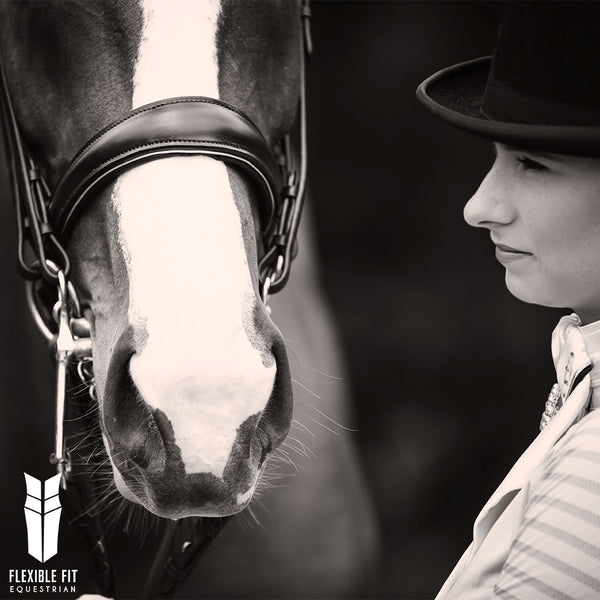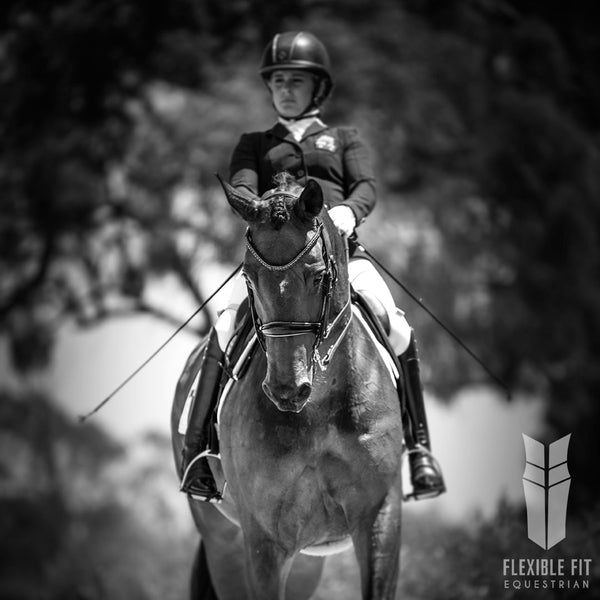
What noseband should you choose?
Nosebands are often a topic of great debate. While it's true that some horses will prefer a particular style of noseband, a lot of horse behaviour extends from the misuse of nosebands.
It is important to note that whichever noseband you choose, and for whatever purpose you choose that noseband, ANY noseband can be used to cause pain or discomfort to your horse if used incorrectly.
Listed below is a summary of the noseband styles we carry and some of the benefits and considerations of each.
STRAIGHT vs ANATOMICAL
Our straight nosebands are what you might see in any bridle store. They are traditional, suit a wide variety of horses, and come in a large range of styles. However, they are thinner than other styles, meaning that any amount of pressure transmitted from the noseband into the horses face is dispersed over a smaller area.
Our anatomical shape are wider at the bridge of the nose and narrow towards the sides. Not to be confused with the host of 'anatomical', 'ergonomic' etc style nosebands on the market these days, our Anatomical shape came before them all and is a basic, unobtrusive way to disperse pressure over a larger surface area without drastically changing the overall appearance. This does create a slightly chunkier noseband and may not be aesthetically suitable for extremely fine faced horses.
CRANK vs CAVESSON
Crank nosebands can get a bad rap, but really they are only problematic if used incorrectly (are you seeing a theme here?). Crank nosebands create an even pressure on the face as they have a sliding chin pad and any increase in pressure during tightening comes from both sides of the noseband. They also allow the crank strap and the nose piece to sit at different angles due to the rings the crank strap passes through - this can really assist fit on horses with an unusual shape head. These nosebands are VERY easy to overtighten, and doing so can be to the significant detriment of your horse, compressing and potentially damaging sensitive nerves and blood vessels and pushing cheeks into teeth.
Cavesson nosebands are a bit more traditional, and potentially have less room for user error. While these still CAN be overtightened, it's not as easy to do as with a crank due to the single directional buckle. A normal cavesson would produce an uneven pressure due to the uneven padding, however our cavessons have been cleverly developed with a sliding chin pad that negates this common issue. They are a comfortable, safe, simple option for uncomplicated horses.
HANOVERIAN vs CONVERTER
Hanoverian nosebands have a fixed tab for the flash strap to pass through. This tab is stitched into the noseband itself, and cannot be removed save for a sharp pair of scissors (not recommended!). This is perfect if you know you will always use a flash, as the fixed tab is smaller and neater than the removable one.
Our converter nosebands are just that - convertible! The flash tab is completely removable. If you use a flash, great. If you don't, the tab simply slips out from between the padding and the leather. The drawbacks of this style is that the tab is larger and less neat, and can be easy to lose. All of our converter nosebands will ship with a tab and flash, even if they are sold as part of a double bridle. It's simple to use and undetectable once removed.
DROP NOSEBANDS
While once considered 'old fashioned', drop nosebands have returned to the training and competition scene due to their many benefits.
They are amazing for young horses who may not have become completely confident in the contact, as well as for horses who demand complete stability of the bit within the mouth. Due to the fact that they sit below the bit, when fitted correctly they support the bit itself and create a still, stable feeling for the horse. They also encourage a more consistent connection, as they apply slight pressure only when the horse opens it's mouth, but immediately release this pressure when the horse closes it's mouth.
In addition to this, the design also avoids many of the sensitive areas of the face, including the infraorbital nerve, the sensitive tissues of the cheeks and teeth, and the blood vessels under the jowl.
Drop nosebands can and SHOULD be fitted loosely, and should never be used to strap the mouth closed. This is not their purpose, and will make for a very unhappy horse. Care must be taken to ensure the noseband is sitting on the nasal bone of the horse and not below, as this can restrict breathing and damage the soft tissues.
FIGURE 8 NOSEBAND
A staple in every jumping stable, the figure 8 noseband is one for strong horses. Also known sometimes as the Grackle noseband, Mexican noseband, or cross over noseband.
The fit of these nosebands can vary between brands and designs, but at their core, they are designed to prevent a horse from crossing their jaw in order to avoid a contact. They do this by creating a point of pressure high up under the chin as well as below the bit, both mechanically and physiologically limiting lateral movement of the jaw.
A benefit to this noseband is that it avoids the area behind the bit where the cheeks sit on top of the teeth, and due to the padded cross over point, also sits off the side of the face where other sensitive nerves exit the skull.
Make no mistake, this is a strong noseband for strong horses, but that doesn't make it evil. Used correctly, it supports the bit within the mouth, and by preventing evasions, it can allow the horse to focus more on it's job, creating a safer and more enjoyable ride. Like any other noseband, this noseband should never be over tightened. Every horse needs movement in it's jaw to chew and swallow, even strong horses.
ERGONOMIC DUO NOSEBAND
This was one of the first 'ergonomic' designs to become popularized in the modern bridle industry. While similar to many other brands, our version has a few clever twists to make it even more versatile.
This noseband has been designed to avoid as many possible nerves, blood vessels, and sensitive areas on the horses face. This includes the infraorbital nerve, the cheeks, the teeth, the blood vessels under the jowl. For a more in-depth product description, make sure to check out the product page.
What makes ours different from some of the others, is that it can be used either with or without the bit hangers (included). Use with the bit hangs helps create stability, and also transfers some of the bit pressures onto the noseband itself, good for horses who may be strong but object to strong bit pressure. Use without the bit hangers allows for more lateral movement of the bit, which can be helpful for horses who may tend to 'hang' on one side, or who are simply uncomplicated in a standard style bridle and may not need any drastic changes.


 USD $
USD $
 SEK
SEK
 CAD
CAD
 GBP
GBP
 EUR
EUR
 DKK
DKK